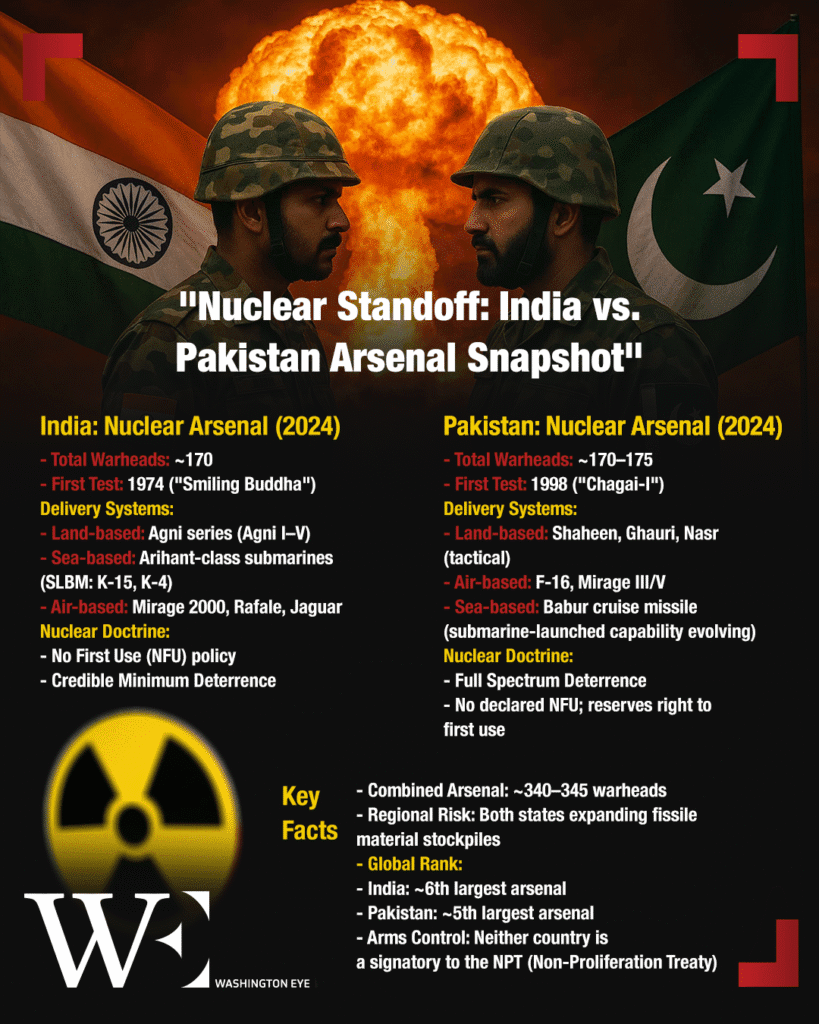The world’s most volatile nuclear standoff just got more dangerous. In a stunning escalation of tensions, India confirmed on May 6 that it had launched coordinated air and missile strikes across the Line of Control into Pakistan-administered Kashmir — the most aggressive cross-border military action in years.
“Operation Sindoor”, a series of missile strikes targeting nine sites in Pakistan and Pakistan-administered Kashmir, were in retaliation for a terrorist attack on April 22 in Pahalgam, Indian-administered Kashmir, which killed 26 Hindu tourists. India attributed the attack to The Resistance Front, a group linked to Pakistan-based Lashkar-e-Taiba. The Indian government described the operation as “measured, focused, and non-escalatory”, emphasizing that it targeted terrorist infrastructure while avoiding civilian casualties. However, Pakistani authorities reported that the strikes resulted in 26 deaths, including civilians, and condemned them as an “act of war”.
In response, Pakistan conducted its own airstrikes, claiming to have hit Indian military targets and downed five Indian jets, although these claims remain unverified by India. The situation has led to intensified skirmishes along the Line of Control (LoC), with both sides exchanging artillery fire and reports of civilian casualties mounting.
The Nuclear Question: Could It Go Nuclear?
The current escalation has reignited fears of a potential nuclear confrontation between the two nations. Both India and Pakistan possess significant nuclear arsenals, with estimates suggesting that India has approximately 172 nuclear warheads, while Pakistan has around 170, though some analyses indicate Pakistan could have more, possibly up to 200.
Historically, both countries have maintained a policy of nuclear deterrence, with Pakistan adopting a “first-use” doctrine and India adhering to a “no first use” policy. However, the current crisis has seen heightened rhetoric, with Pakistani officials warning of a “decisive response” to Indian aggression. The suspension of the Indus Waters Treaty by India, a critical agreement for Pakistan’s water supply, has further exacerbated tensions, leading to concerns that Pakistan might perceive such actions as existential threats, potentially lowering the threshold for nuclear engagement.
Experts caution that while a full-scale nuclear war remains unlikely, the risk of miscalculation or accidental escalation cannot be dismissed, according to The Guardian. The current situation mirrors past crises, such as the 2019 Pulwama attack, but with increased volatility due to domestic pressures, regional instability, and the involvement of non-state actors.
Strategic and Global Implications
The current escalation between India and Pakistan carries implications far beyond the Himalayan frontier. At its core, this crisis exposes how fragile South Asia’s deterrence architecture has become — and how little margin for error exists in a nuclearized environment where conventional and sub-conventional conflicts are increasingly interwoven.
For India, the strikes represent a shift toward a more assertive posture often termed “compellence by punishment”. While framed as limited and precise, these strikes signal a willingness to cross the LoC without waiting for international validation or prolonged diplomatic process. This not only upends expectations of restraint under the “No First Use” doctrine but also pressures Pakistan’s strategic calculus: if India normalizes low-intensity cross-border operations, Pakistan may feel compelled to recalibrate its own deterrence thresholds.
Pakistan, facing mounting internal political instability and economic fragility, now risks strategic overextension. Historically reliant on a doctrine of “full-spectrum deterrence”, Pakistan has hinted at rapid escalation in the face of conventional disadvantage. The danger here lies in the ambiguity — especially if future Indian strikes are seen as threatening critical infrastructure or military command nodes. Such a scenario could activate Pakistan’s tactical nuclear posture, a doctrinal grey zone that remains poorly understood and deeply destabilizing.
On the global front, the muted response from major powers like the United States and China is telling. While both have urged restraint, neither has stepped forward as a mediator with the urgency seen in past crises, such as Kargil in 1999 or Balakot in 2019. This diplomatic vacuum — worsened by global attention being consumed by conflicts in Eastern Europe and the South China Sea — leaves room for miscommunication and miscalculation to spiral unchecked.
Furthermore, India’s suspension of the Indus Waters Treaty — a foundational confidence-building measure since 1960 — raises alarms about the weaponization of shared resources, a move that could provoke unpredictable escalation if Pakistan perceives it as an existential threat. Water security, already fragile in the region, is now squarely part of the strategic equation.
A Final Note
While the prospect of a nuclear conflict remains the gravest of outcomes — and one that both nations ostensibly seek to avoid — the current trajectory is perilously close to breaching traditional red lines. The precision and scale of India’s strikes, Pakistan’s retaliatory posture, and the increasingly bellicose rhetoric from both sides reveal not only tactical calculations but also deepening strategic distrust. This is not merely a military standoff; it is a failure of diplomacy, risk management, and crisis communication.
The repeated involvement of non-state actors, unresolved grievances over Kashmir, and the erosion of past confidence-building mechanisms have all contributed to a security environment where even limited exchanges can trigger cascading escalations. Add to this the risk of miscalculation, domestic political pressures, and emerging technologies that compress decision-making timelines, and the picture becomes even more alarming.



















